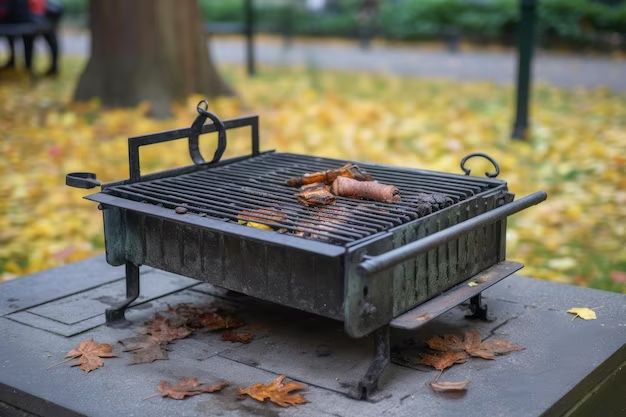Portable grills, also known as tailgating grills or camping grills, allow you to grill food on-the-go. Determining where to put your portable grill depends on the type of grill you have and the location. There are some important safety considerations to keep in mind as well.
Page Contents
Types of Portable Grills
There are a few main types of portable grills to consider:
- Small tabletop grills – These are compact and lightweight grills that sit on top of a picnic table or other surface. Many run off of propane or charcoal.
- Larger stand-alone grills – These freestanding grills are larger and heavier. They often have two or more burners and may run off of propane or charcoal.
- Disposable grills – These single-use grills come prepackaged with charcoal or other fuel source. They are very portable but can only be used once.
The type of portable grill you choose can impact placement. Small tabletop grills are the most flexible since they can sit on any sturdy, level surface. Larger stand-alone grills take up more space and may need a more open area. Disposable grills are better for one-time tailgating or camping and can be placed in cleared dirt or sand.
Places to Use a Portable Grill
Here are some common locations to use a portable grill:
Tailgating
Tailgating at sporting events or concerts is a popular place to use a portable grill. Most venues that allow tailgating have designated parking or lawn areas for grilling. Be sure to check the venue’s rules on placement within the tailgating area. Many require keeping grills on pavement or gravel instead of directly on grass or turf.
Campgrounds
Campgrounds almost always have designated grilling areas, usually with a grated surface or fire pit. Avoid placing a portable grill directly on the ground in a campsite, as it could scorch or start a fire. Grilling is usually not permitted on picnic tables for safety reasons. Look for the campground’s posted rules on any restricted areas.
Parks and Beaches
It’s important to check the local laws and rules before using a portable grill in a park or on a beach. Often grilling is only allowed in certain cleared areas with concrete or stone surfaces. Grilling on sand or directly on grass risks starting a fire. Avoid placing hot grills on or near picnic tables.
Backyard or Patio
A patio, deck or backyard makes an ideal spot for a portable grill at home. Ensure the surface is level and place the grill a safe distance from siding, fences, furniture, or anything flammable. Use caution on wooden decks or surfaces. A drip pan can help catch grease and coal remnants underneath the grill.
Balconies
It’s usually not recommended to use a grill on an apartment balcony, as they pose a major fire risk. However, some apartments do allow electric or propane grills on balconies, so check your building’s rules. If permitted, keep the grill as far from the building as possible and supervise it at all times.
Safety Tips
No matter where you put your portable grill, keep these safety guidelines in mind:
- Place on a sturdy, level, nonflammable surface away from anything flammable
- Don’t put directly on grass, sand, or uneven ground
- Maintain a perimeter of at least 3 feet around the grill
- Keep away from wooden surfaces like picnic tables and fences
- Don’t leave a hot grill unattended
- Extinguish coals and ash thoroughly after cooking
- Let grill cool completely before moving or storing
Ideal Surfaces for Portable Grills
The best surfaces for placing a hot portable grill include:
| Surface | Benefits |
|---|---|
| Concrete | Withstands heat well, nonflammable |
| Asphalt | Hard, flat, nonflammable |
| Patio Pavers | Designed for grills, nonflammable |
| Gravel | Nonflammable, allows ventilation |
| Fire Pits | Contained, designed for fires |
| BBQ Mats | Protective mats catch drippings |
Avoid placing portable grills directly on grass, dirt, sand, or uneven ground. The heat and grease drippings can damage or start fires on these combustible surfaces.
How to Choose an Outdoor Location
If grilling at a park, beach, or other outdoor space, follow these tips for choosing the best spot:
Check for Designated Grilling Zones
Many public outdoor areas will have designated grill zones, which are safer cleared areas designed for grilling. These are ideal spots and may include grates, BBQ pits, or fire rings.
Look for Existing Fire Pits
If there are no designated zones, look for existing fire pits in cleared dirt or sand areas. This contains the heat and sparks within a safe contained area.
Select a Hard Surface
If no fire pits exist, scout for a hard, flat surface like concrete or pavement. This prevents fire risk from grease drippings or coals. Avoid wooden picnic tables or grassy areas.
Check for Breeze
Position the grill away from areas with heavy winds, which can blow embers around. Look for a sheltered area or set up a wind block if needed.
Allow Space
Make sure there is adequate clearance around the grill, at least 10 feet from tents, shrubs, vehicles, or other flammable objects. Don’t crowd the area.
Conclusion
Portable grills provide the convenience of grilling on-the-go. But proper placement is crucial for both optimal cooking and safety. The best spots have hard, nonflammable surfaces like concrete or gravel that won’t catch fire. Allow plenty of clearance from flammable items. Supervise the grill at all times when hot. With some caution, portable grills allow you to enjoy delicious BBQ flavor wherever you go.

